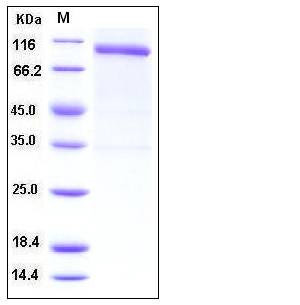Human Nogo Receptor / NOGOR / RTN4R Protein (His & Fc Tag)
NGR,NOGOR
- 100ug (NPP4122) Please inquiry
| Catalog Number | P10466-H03H |
|---|---|
| Organism Species | Human |
| Host | Human Cells |
| Synonyms | NGR,NOGOR |
| Molecular Weight | The recombinant human RTN4R/Fc is a disulfide-linked homodimer. The reduced monomer consists of 669 amino acids and has a predicted molecular mass of 73 kDa. As a result of glycosylation, the apparent molecular mass of rh RTN4R/Fc monomer is approximately 100 kDa in SDS-PAGE under reducing conditions. |
| predicted N | Cys 27 |
| SDS-PAGE |  |
| Purity | > 90 % as determined by SDS-PAGE |
| Protein Construction | A DNA sequence encoding the mature form of human RTN4R (NP_075380.1) (Met 1-Ser 447) was fused with the C-terminal polyhistidine-tagged Fc region of human IgG1 at the C-terminus. |
| Bio-activity | Measured by its ability to bind recombinant human RTN4 in a functional ELISA. |
| Research Area | Developmental Biology |Embryogenesis |Germ Layer Formation |Ectoderm Marker |
| Formulation | Lyophilized from sterile PBS, pH 7.4 1. Normally 5 % - 8 % trehalose, mannitol and 0.01% Tween80 are added as protectants before lyophilization. Specific concentrations are included in the hardcopy of COA. |
| Background | Reticulon 4 receptor (RTN4R), also known as Nogo-66 Receptor (NgR), is a glycosylphosphoinositol (GPI)-anchored protein that belongs to the Nogo recptor family including three members. Mouse RTN4R cDNA contains 10 LRP (Leucine-rich) repeats. RTN4R is expressed predominantly in neurons and their axons in the central nervous systems (CNS). As a receptor for myelin-derived proteins Nogo, myelin-associated glycoprotein (MAG), and myelin oligodendrocyte glycoprotein (OMG), RTN4R mediates axonal growth inhibition and may play a role in regulating axonal regeneration and plasticity in the adult CNS. It has been shown that RTN4R performs its inhibitory actions by interacting with the p75 neurotrophin receptor (p75NTR), a TNFRSF member also known for modulating the activities of the Trk family and for inducing apoptosis in neurons and oligodendrocytes. RTN4R may be proposed as a potential drug target for treatment of various neurological conditions such as spinal cord injury, CNS lesions, peripheral nerve injury, stroke and Alzheimer's disease (AD). Additionally, RTN4R may play a role in regulating the function of the gap junctions. |
| Reference | 1. Wang, X. et al., 2006, Ann Neurol. 60(5): 540-549. 2. Wang, Y.Z. et al., 2006, Neuroreport.17(6):605-609. 3. Zhu, H.Y. et al., 2007, Hum Pathol. 38(3): 426-434. 4. David, S. et al., 2008, Trends Neurosci. 31(5): 221-226. 5. Jiang, W. et al., 2009, Transl Res. 154(1): 40-48. 6. Zhang, L. et al., 2009, J Neurosci, 9(19): 6348-6352. |
